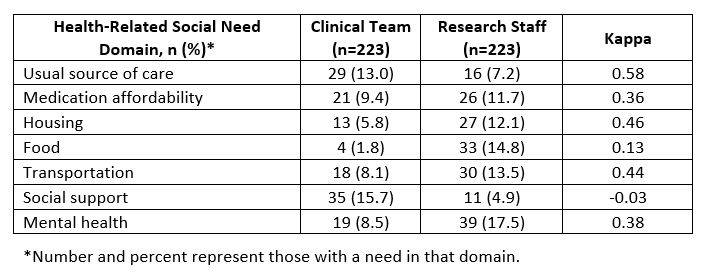Background: Recognizing the significant effect that social factors have on health outcomes, national stakeholders have developed policies requiring healthcare organizations to identify and address health-related social needs (HRSN). However, the effectiveness of HRSN screening strategies remains unclear. Notably, policymakers provide minimal guidance on how screening should be conducted and allow hospitals to use self-selected screening instruments. We sought to assess HRSN screening effectiveness by comparing 1) clinical staff and research staff screening using the same instrument and 2) research staff screening using two different instruments.
Methods: This observational study took place on the general medicine services at a large urban academic hospital serving a diverse patient population. Nurses began screening each newly admitted patient for six social needs in April, 2021. The hospital screening instrument was developed by an improvement team based on a review of published instruments and identified HRSNs related to usual source of care, medication affordability, housing, food, transportation, social support, and mental health. Research staff conducted structured interviews of hospitalized patients, using the hospital screening instrument and the Centers for Medicare and Medicaid Services’ Accountable Health Communities Health-Related Social Needs (AHC HRSN) questionnaire. We calculated Kappa statistics to assess agreement between clinical staff and research staff on the presence of social needs using the hospital screening instrument. We also calculated Kappa statistics on data collected by research staff for the three social needs assessed by both the hospital screening instrument and the AHC HRSN.
Results: Analysis of complete HRSN screening data from 223 patients revealed poor to moderate agreement between clinical and research staff screenings using the hospital screening instrument (Kappa: -0.03 to 0.58; Table 1). Clinical staff identified fewer patients with needs related to medication affordability, housing, food, transportation, and mental health but identified a higher proportion with needs related to usual source of care and social support. Conversely, research staff demonstrated substantial agreement in screenings for housing, food, and transportation needs using the two different instruments (Kappa: 0.67-0.76; Table 2).
Conclusions: Our study revealed poor agreement between clinical staff and research staff HRSN screenings using the same instrument, yet substantial agreement for screenings conducted by research staff using two different instruments. Clinical staff generally identified a smaller proportion of patients with needs. The manner by which HRSN screening is conducted appears to influence its effectiveness. Further research is needed to characterize barriers to effective HRSN screening, which may include workload, workflow, and reluctance of patients to share HRSN information with clinical staff.


